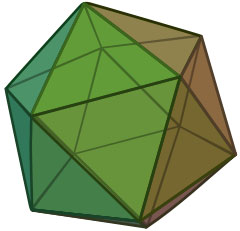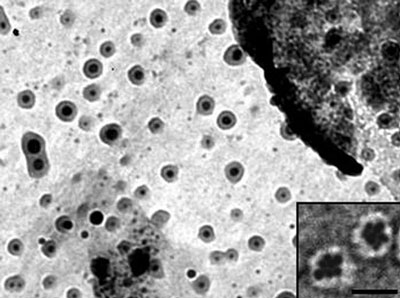| Posted: Apr 24, 2009 | |
Self-assembled DNA nanocapsules for drug delivery |
|
| (Nanowerk Spotlight) One of the challenges of this early phase of bottom-up nanotechnologies is to move from the production of nanomaterials to the design and fabrication of functional three-dimensional structures through self-assembly. To that end, DNA has become a popular 'building material' for nanotechnology researchers. | |
| Studies have already shown the complexity of architecture that is achievable using DNA as building blocks. For instance, nanofabrication via molecular self-assembly has already resulted in simple DNA polyhedra with connectivities of a cube, octahedron, and a tetrahedron. | |
| Platonic solids – any one of five solids whose faces are congruent regular polygons and whose polyhedral angles are all congruent – are the most efficient at enclosing large volumes. The more complex the polyhedron, the greater its ability to encapsulate cargo, because the capsule size can be maximized while keeping the pore-size of the capsule minimal. The most complex platonic solid is the icosahedron and therefore this would be most suitable for achieving cargo encapsulation. | |
 |
|
| A regular icosahedron. (Image: Wikimedia) | |
| The DNA shell of such a capsule could protect vulnerable drugs from degradation by proteins until they reach their target site. It could also prevent dangerous drugs from leaking out until the capsule reaches its intended target. The DNA shell could also allow attachment to a protein that could ferry the drug-loaded capsule to a target. | |
| All these exciting applications can be envisaged, but only if one can first show that it is possible to in fact house another nanoscale entity inside such DNA shells. And this is exactly what a new study by scientists in India shows. The results have been recently published in Angewandte Chemie (Icosahedral DNA Nanocapsules by Modular Assembly). | |
| "DNA polyhedra may be envisaged as intelligent drug-delivery systems due to the rich information encodable on the framework that could enable targeted delivery of encapsulable entities," Yamuna Krishnan tells Nanowerk. "Creating complex polyhedra implies practical realization of these projected applications due to maximization of encapsulable volumes while preserving small pore size. Current strategies preclude the construction of such complex polyhedra." | |
 |
|
| TEM image of the gold nanoparticles encapsulated within DNA icosahedra. The bright-field low-resolution TEM image shows the dense core of metallic particles within the cages. The inset shows representative high-resolution images in which the individual gold nanoparticles can be seen to be present within the icosahedral cages. Scale bar: 50 nm. (Reprinted with permission from Wiley) | |
| Krishnan is a scientist at the National Centre for Biological Sciences in Bangalore, India, where she heads the Chemical Biology Group. Just recently we have written about her work on DNA nanomachines (Synthetic DNA nanomachines go to work inside living cells). Her latest research deals with the first demonstration of function for DNA polyhedra, constructs where the 3D framework consists of DNA double helices. | |
| "We have constructed the most complex DNA-based platonic solid, namely an icosahedron via a unique modular assembly strategy and demonstrated this functional aspect for DNA polyhedra by encapsulating gold nanoparticles from solution," says Krishnan. | |
| For the first time, Krishnan and her team show that these beautiful architectures could actually also have a useful function. | |
| "We constructed our icosahedron through a unique modular assembly strategy and demonstrated the functional aspect for DNA polyhedra by encapsulating gold nanoparticles from solution," she says. "The advantage of our technique is that the polyhedra are obtained in extremely high yields. This is because with every step, the modules start curving into cup-shaped structures. In the final step, two cup-shaped half-icosahedra can join to form a whole icosahedron efficiently encapsulating any cargo present in the solution. This modular assembly strategy is thus absolutely key to the demonstration of cargo encapsulation by DNA polyhedra." | |
| Having demonstrated the assembly process, Krishnan's team is now looking to the fabrication of more complex DNA polyhedra. Key tasks for research efforts will be to determine suitable drug candidates for encapsulation; encapsulation of these molecules within DNA polyhedra; designing proteins which can bind to these structures on their outer surfaces; and then to study the delivery of these drug molecules in various tissues or cells. | |
| Krishnan points out that the main challenges in this work are to improve the encapsulation abilities of these polyhedra and to design methods to avoid leakage of encapsulated species. "Another challenge is to see how well behaved – i.e. site specific and stable – these carriers can be in biological environments and how much immunogenicity they have, as these will be crucial to address if they are used in targeted drug delivery," she says. "Also, elucidating the mechanisms by which the encapsulated molecules are released in the cells or tissues will be interesting to study." | |
 By
Michael
Berger
– Michael is author of three books by the Royal Society of Chemistry:
Nano-Society: Pushing the Boundaries of Technology,
Nanotechnology: The Future is Tiny, and
Nanoengineering: The Skills and Tools Making Technology Invisible
Copyright ©
Nanowerk LLC
By
Michael
Berger
– Michael is author of three books by the Royal Society of Chemistry:
Nano-Society: Pushing the Boundaries of Technology,
Nanotechnology: The Future is Tiny, and
Nanoengineering: The Skills and Tools Making Technology Invisible
Copyright ©
Nanowerk LLC
|
|
|
Become a Spotlight guest author! Join our large and growing group of guest contributors. Have you just published a scientific paper or have other exciting developments to share with the nanotechnology community? Here is how to publish on nanowerk.com. |
|
